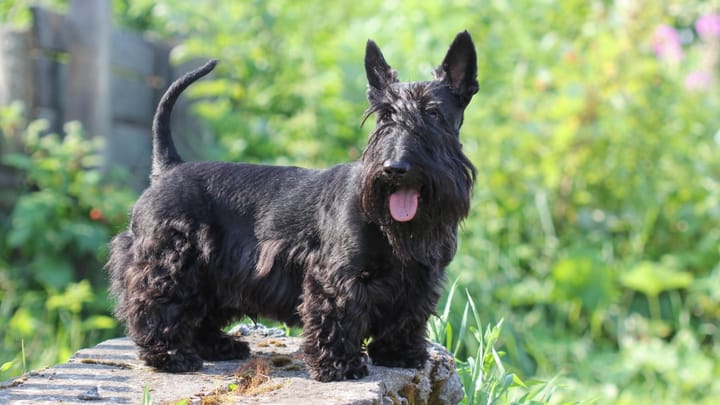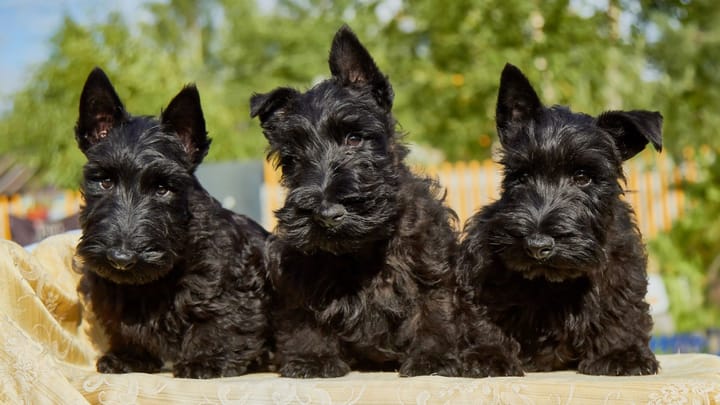Scottish Terrier
Other names : Scottie, Aberdeen Terrier


The Scottish Terrier is a friendly dog, albeit rather feisty at times. They make charming companions and are suitable for most family environments. These terrier dogs are small-sized, with short legs. They look quite charming with the feathering around their legs and muzzles. Sometimes known as Aberdeen Terriers, they are a popular pet worldwide, not only in the United Kingdom. Playful and friendly as a small puppy, the Scottish Terrier, when more mature, can be a steady, jaunty and bold adult dog. The breed is quite independent and fearless, however also quite stern and stubborn at times.
|
Life expectancy |
The Scottish Terrier has a life expectancy of between 12 and 14 years |
|
Temperament |
|
|
Size |
Small
|
|
Adult size |
Female
Between 10 and 11 in
Male
Between 10 and 11 in
|
|
Adult weight |
Female
Between 18 and 22 lb
Male
Between 18 and 22 lb
|
|
Coat colour
Coat colours of this breed are usually solid black, dark grey or brindle. Much rarer is the dog with a wheaten coloured coat. |
Black Sand White |
|
Type of coat
A short to medium length coat with feathering that is marginally longer. The dog’s coat is quite hard and wiry and very dense. The coat consists of a harsh top coat with a dense, shorter undercoat. The Scottish terrier generally has feathering on the muzzle and around the face, with the appearance of a small beard too. |
Long |
|
Eye colour
Almond shaped, dark brown eyes. |
Brown
|
|
Purchase price |
The Scottish Terrier costs between £710 and £990 |
Scottish Terriers are tough little canines who are not only independent but also very determined. Very loving pets, who are fine with children and their family, but quite wary of any strangers. They are very affectionate and do like a cuddle. They can be very vocal when someone is at the door and likewise, often quite snappy when unsure of certain situations.
More details about the Scottish Terrier
Scottish Terrier: Origins and history
Despite some confusion around the Scottish Terrier breed, as many terriers in Scotland are known as Scottish or Scotch Terriers, this breed was first documented during the late 1800s. A group of Highlanders used the terriers to hunt vermin in the forests and mountains of Scotland. JB Morrison drafted the first breed standard while John Naylor has the claim to fame of introducing the Scottish Terrier to the United States around 1883. The word terrier is taken from the Latin word “Terra”, meaning earth.
After World War II, the breeds’ popularity soared. Several of the American Presidents have owned Scottish terriers and today, the breed is a popular show and pet dog.
Physical characteristics of the Scottish Terrier
The Scottie is a muscular, robust small dog, with a dignified and feisty look about their long heads. Their endearing appearance is due not only to their eyebrows, but also the feathery beard. A Scottish Terrier’s eyes always look intelligent, alert and keen. With a large black nose and pointed ears which are always standing erect. A moderately long neck and sloping shoulders, together with broad front legs and chest give the dog a powerful stance.
In addition, a short back, broad rump and muscular hindquarters give a well-balanced body shape. The dog’s feet are well-padded with the front paws being larger than the rear. The Scottie holds his moderately long tail erect or with just a slight curve.
FCI classification of the Scottish Terrier
-
Group 3 - Terriers
-
Section 2 : Small sized Terriers
Scottish Terrier: Characteristics
Scottish Terrier: Behaviour
Training a Scottish Terrier
As a smart dog who is keen to learn, training must be consistent and begin early in the dog’s life. However, they very easily pick up bad habits too. A terrier is never happier than when he has something to keep him busy, but likewise, is happy to chill out at home relaxing. Successful training routines must not be too repetitive and be very interesting to keep the dog focused on the task in hand. Avoid heavy handed training and harsh reprimands and always provide positive reinforcement for the best results.
Scottish Terrier: Lifestyle
Breed compatibility Scottish Terrier
Scottish Terrier: Purchase price
If you are researching for a Scottish terrier, expect the cost to be anywhere from £710 for a non-registered pup to over £990 for a pedigree, KC registered dog. Add on the costs of vaccinations, insurance and weekly food bills and you are looking at between £50 to £80 each month in additional costs.
Scottish Terrier: Shedding
Light
These terriers shed hair steadily all year round, but even more so during the Spring and Autumn seasons.
Scottish Terrier: Grooming
Extensive grooming routines are required to keep these small dogs looking their very best. They have a double coat, with a wiry outer coat which needs almost daily brushing. In addition, they need to be clipped and trimmed professionally every 8 to 12 weeks, to keep their coats free from tangles. When eating their meals, the Scottie’s beard will very easily become matted with his food. The dog’s ears need to be inspected regularly, to prevent any wax build up.
Scottish Terrier: Health
The Scottish Terrier, with a healthy disposition, has a life expectancy of between 12 to 14 years.
Originally bred as a hunter, to search out prey such as foxes and badgers, the Scottie is definitely a robust little character. Although he has the appearance of a small, short-legged dog, he is of a compact and sturdy build.
Dogs breeds that have thick, double, dense coats can often overheat in high temperatures. Although the Scottish Terrier needs frequent grooming, his thick hair will raise his body temperature during the hot summer months.
Considering that your Scottish Terrier is in good health, has a good level of activity and a thick, dense coat, he should tolerate the cold weather very well. His coarse coat will certainly keep him warm, but his short legs won’t enjoy plodding through cold snow and icy conditions.
As with the majority of small dogs, control over the amount of food and treats given must be monitored. Likewise, adequate exercise on a daily basis must be provided to prevent weight gain. Obesity can be a problem for Scottie dogs that live a sedentary lifestyle.
- Scottie cramp – uncoordinated muscle/leg spasms
- Epilepsy
- Tumours
- Heart disease
- Allergies
- Eye issues
- Luxating patella – dislocating knee-cap
- Canine hip dysplasia
- Brain disease
- Blood clotting problems






